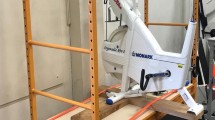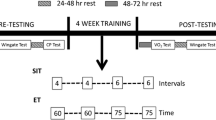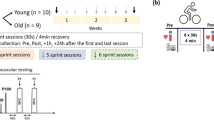Abstract
Purpose
Sprint interval training (SIT) stimulates rapid metabolic adaptations within skeletal muscle but the nature of neuromuscular adaptions is unknown. Omega-3 polyunsaturated fatty acids (N-3 PUFA) are suggested to enhance neuromuscular adaptations to exercise.
Methods
We measured the neuromuscular adaptations to SIT (Study-1) and conducted a placebo-controlled randomized double blinded study to determine the effect of N-3 PUFA supplementation on neuromuscular adaptations to SIT (Study-2). In Study-1, seven active men (24.4 ± 2.6 years, VO2 peak 43.8 ± 8.7 ml kg min−1) completed 2-weeks of SIT with pre- and post-training 10 km cycling time trials (TT). In Study-2, 30 active men (24.5 ± 4.2 years, VO2 peak 41.0 ± 5.1 ml kg min−1) were randomly assigned to receive N-3 PUFA (2330 mg day−1) (n = 14) or olive oil (n = 16) during 2-weeks of SIT with pre- and post-training TTs. Four week post-training, a SIT session and TT were also performed. Change in neuromuscular function was assessed from resting twitches, quadriceps maximal voluntary contraction (MVC) force, and potentiated twitch force (Q tw).
Results
Study-1 showed that SIT did not elicit significant neuromuscular adaptations. Study-2 showed that N-3 PUFA supplementation had no significant effect on neuromuscular adaptations. Training caused lower MVC force [mean ± SD; N-3 PUFA −9 ± 11%, placebo −9 ± 13% (p < 0.05 time)] and Q tw peripheral fatigue [N-3 PUFA −10 ± 19%, placebo −14 ± 13% (p < 0.05 time)]. TT time was lower after training in all groups [Study-1 −10%, Study-2 N-3 PUFA −8%, placebo −12% (p < 0.05 time)].
Conclusion
Two weeks of SIT improved TT performance in the absence of measurable neuromuscular adaptations. N-3 PUFA supplementation had no significant effect on SIT training adaptations.





Similar content being viewed by others
Abbreviations
- DHA:
-
Docosahexaenoic acid
- DPA:
-
Docosapentaenoic acid
- EMD:
-
Electromechanical delay
- EMG:
-
Electromyography
- EPA:
-
Eicosapentaenoic acid
- HR:
-
Heart rate
- LFF:
-
Low-force frequency fatigue
- M AMP :
-
M-wave amplitude
- N-3:
-
Omega-3
- MCT:
-
Monocarboxylate transporter
- MVC:
-
Maximal voluntary contraction
- PUFA:
-
Polyunsaturated fatty acid
- Q tw :
-
Potentiated twitch force
- RFD:
-
Rate of force development
- SIT:
-
Sprint interval training
- tAUC:
-
Twitch area under the curve
- tHRT:
-
Time to half relaxation
- tPF:
-
Twitch peak force
- tRFD:
-
Twitch rate of force development
- tTP:
-
Twitch time to peak force
- TT:
-
Time trial
- VA:
-
Voluntary activation
- VL:
-
Vastus lateralis
- VM:
-
Vastus medialis
- VO2 :
-
Volume of oxygen consumed
- W max :
-
Watt max
References
Amann M, Dempsey J (2008) Locomotor muscle fatigue modifies central motor drive in healthy humans and imposes a limitation to exercise performance. J Physiol 586:161–173
Amann M, Eldridge M, Lovering R, Stickland M, Pegelow D, Dempsey J (2006) Arterial oxygenation influences central motor output and exercise performance via effects on peripheral locomotor muscle fatigue in humans. J Physiol 575:937–952
Amann M, Proctor L, Sebranek J, Pegelow D, Dempsey J (2009) Opioid-mediated muscle afferents inhibit central motor drive and limit peripheral muscle fatigue development in humans. J Physiol 587:271–283
Beelen A, Sargeant A (1993) Effect of prior exercise at different pedalling frequencies on maximal power in humans. Eur J Appl Physiol 66:102–107
Bracco U (1994) Effect of triglyceride structure on fat absorption. Am J Clin Nutr 60:1002S–1009S
Brockerhoff H, Hoyle R, Hwang P, Litchfield C (1968) Positional distribution of fatty acids in depot triglycerides of aquatic animals. Lipids 3:24–29
Burgomaster KA, Hughes SC, Heigenhauser GL, Bradwell SN, Gibala MJ (2005) Six sessions of sprint interval training increases muscle oxidative potential and cycle endurance capacity in humans. J Appl Physiol 98:1985–1990
Burgomaster KA, Heigenhauser G, Gibala MJ (2006) Effect of short-term sprint interval training on human skeletal muscle carbohydrate metabolism during exercise and time-trial performance. J Appl Physiol 100:2041–2047
Burgomaster KA, Cermak NM, Philips SM, Benton C, Bonen A, Gibala MJ (2007) Divergent response of metabolite transport proteins in human skeletal muscle after sprint interval training and detraining. Am J Physiol Regul Integr Comp Physiol 292:R1970–R1976
Button D, Behm D (2008) The effect of stimulus anticipation on the interpolated twitch technique. J Sport Sci Med 7:520–524
Chen C, Liu Z, Bazinet R (2011) Rapid de-esterification and loss of eicosapentaenoic acid from rat brain phospholipids: an intracerebroventricular study. J Neurochem 116:363–373
Christensen M, Mortimer B, Hoy C, Redgrave T (1995) Clearance of chylomicrons following fish oil and seal oil feeding. Nutr Res 15:359–368
Cochran A, Myslik F, MacInnis M, Percival M, Bishop D, Tarnopolsky M, Gibala MJ (2015a) Manipulating carbohydrate availability between twice-daily sessions of high-intensity interval training over two weeks improves time-trial performance. Int J Sport Nutr Exerc Metab 25(5):463–470
Cochran A, Percival M, Thompson S, Gillen J, MacInnis M, Potter M, Tarnopolsky M, Gibala MJ (2015b) Beta-alanine supplementation does not augment the skeletal muscle adaptive response to six weeks of sprint interval training. Int J Sport Nutr Exerc Metab 25(6):541–549
Fernandez-del-Olmo M, Rodriguez FA, Iglesias M, Marina M, Benitez A, Vallejo L, Accero R (2011) Isometric knee extensor fatigue following a Wingate test: peripheral and central mechanisms. Scand J Med Sci Sports 23(1):57–65
Griffin S, Cafarelli E (2003) Neural excitability following resistance training studied with transcranial magnetic stimulation. Med Sci Sports Exerc 35:S293
Hermens H, Frericks B, Disselhorst-Klug C, Rau G (2000) Development of recommendations for SEMG sensors and sensor placement procedures. J Electromyogr Kinesiol 10:361–374
Lewis E, Radonic P, Wolever T, Wells G (2015) 21 days of mammalian omega-3 fatty acid supplementation improves aspects of neuromuscular function and performance in male athletes compared to olive oil placebo. J Int Soc Sports Nutr 12:28. doi:10.1186/s12970-015-0089-4
Little JP, Safdar A, Bishop D, Tarnopolsky M, Gibala MJ (2011) An acute bout of high-intensity interval training increases the nuclear abundance of PGC-1α and activates mitochondrial biogenesis in human skeletal muscle. Am J Physiol Regul Integr Comp Physiol 300:R1303–R1310
Martin V, Kerherve H, Messonnier LA, Banfi J, Geyssant A, Bonnefoy R, Feasson L, Millet GY (2010) Central and peripheral contributions to neuromuscular fatigue induced by a 24-h treadmill run. J Appl Physiol 108:1224–1233
McGlory C, Galloway SD, Hamilton DL, McClintock C, Breen L, Dick JD, Bell J, Tipton K (2014) Temporal changes in human skeletal muscle and blood lipid composition with fish oil supplementation. Prostaglandins Leukot Essent Fatty Acids 90:199–206
Millet GY, Tomazin K, Verges S, Vincent C, Bonnefoy R, Boisson R, Gergele L, Feasson L, Martin V (2011) Neuromuscular consequences of an extreme mountain ultra-marathon. PLoS One 6:e17059
Paltauf F, Esfandi F, Holasek A (1974) Stereo-specificity of lipases. Enzymatic hydrolysis of enantiomeric aklyl diglycerides by lipoprotein lipase, lingual lipase and pancreatic lipase. FEBS Lett 40:119–123
Patten G, Abeywardena M, Mcmurchie E, Jahangiri A (2002) Dietary fish oil increases acetylcholine and eicosanoid induced contractility of isolated rat ileum. J Nutr 132:2506–2513
Place N, Ivarsson N, Venckunas T, Neyroud D, Brazaitis M, Cheng A et al (2015) Ryanodine receptor fragmentation and sarcoplasmic reticulum Ca2 + leak after one session of high-intensity interval exercise. Proc Natl Acad Sci 112:15492–15497
Rich C, Cafarelli E (2000) Submaximal motor unit firing rates after 8 wk of isometric resistance training. Med Sci Sports Exerc 32:190–196
Rodacki C, Rodacki A, Pereira G, Naliwaiko K, Coelho I, Pequito D, Rernandes L (2012) Fish-oil supplementation enhances the effects of strength training in elderly women. Am J Clin Nutr 95:428–436
Sale D (1988) Neural adaptation to resistance training. Med Sci Sports Exerc 20:S135–S145
Schiano V, Laurenzano E, Brevetti G, De Maio J, Lanero S, Scopacasa F, Chiariello M (2008) Omega-3 polyunsaturated fatty acid in peripheral arterial disease: effect on lipid pattern, disease severity, inflammation profile, and endothelial function. Clin Nutr 27:241–247
Stiefel P, Ruiz-Gutierrez V, Gajon E, Acosta D, Garcia-Donas M, Madrazo J, Villar J, Carneado J (1999) Sodium transport kinetics, cell membrane lipid composition, neural conduction and metabolic control in type 1 diabetic patients. Changes after a low-dose n-3 fatty acid dietary intervention. Ann Nutr Metab 43:113–120
Thomas K, Goodall S, Stone M, Howatson G, St Clair Gibson A, Ansley L (2015) Central and peripheral fatigue in male cyclists after 4-, 20-, and 40-km time trials. Med Sci Sports Exerc 47:537–546
Verges S, Maffiuletti N, Kerherve H, Decorte N, Wuyam B et al (2009) Testing involved a train of 5 stimulations of the femoral nerve to measure twitch characteristics, followed by 3 MVCs described below. J Appl Physiol 106:701–710
Wanasundara U, Shahidi F (1997) Positional distribution of fatty acids in triacylglycerols of seal blubber oil. J Food Lipids 4:51–64
Yoshida H, Kumamaru J, Mawatari M, Ikeda I, Imaizumi K, Tsuji H, Seto A (1996) Lympatic absorption of seal and fish oils and their effecton lipid metabolism and eicosanoid production in rats. Biosci Biotechnol Biochem 60:1293–1298
Acknowledgements
The authors appreciate the help of Cathie Kessler for her technical assistance building the isometric dynamometer and MatLab program for analysis. Thank you to Dr. Bazinet’s laboratory for performing plasma fatty acid analysis and to Ms. Joy Hur assisting with data management. The omega-3 and placebo supplements for this study were donated by Auum Inc.
Author information
Authors and Affiliations
Corresponding author
Ethics declarations
Funding
EJHL was supported by an Ontario Graduate Scholarship, Banting and Best Diabetes Centre studentship and a Peterborough K. M. Hunter scholarship. Equipment for this study was purchased from an Ontario Ministry of Tourism Culture and Sport, Research Program in Applied Sport Sciences operating grant to EJHL.
Conflict of interest
EJHL has received speaking fees and conference travel support from Auum Inc. TMSW is a part owner, President, and Medical Director of Glycemic Index Laboratories, Toronto, Canada and has authored several popular diet books on the glycemic index for which he has received royalties from Phillipa Sandall Publishing Services and CABI Publishers. He has received consultant fees, honoraria, travel funding, or served on the scientific advisory board for McCain Foods, Temasek Polytechnic, Singapore, Glycemic Index Symbol program, CreaNutrition AG, and the National Sports and Conditioning Association. His wife is an employee and part owner of Glycemic Index Laboratories.
Additional information
Communicated by Nicolas Place.
Rights and permissions
About this article
Cite this article
Lewis, E.J.H., Stucky, F., Radonic, P.W. et al. Neuromuscular adaptations to sprint interval training and the effect of mammalian omega-3 fatty acid supplementation. Eur J Appl Physiol 117, 469–482 (2017). https://doi.org/10.1007/s00421-017-3539-7
Received:
Accepted:
Published:
Issue Date:
DOI: https://doi.org/10.1007/s00421-017-3539-7




